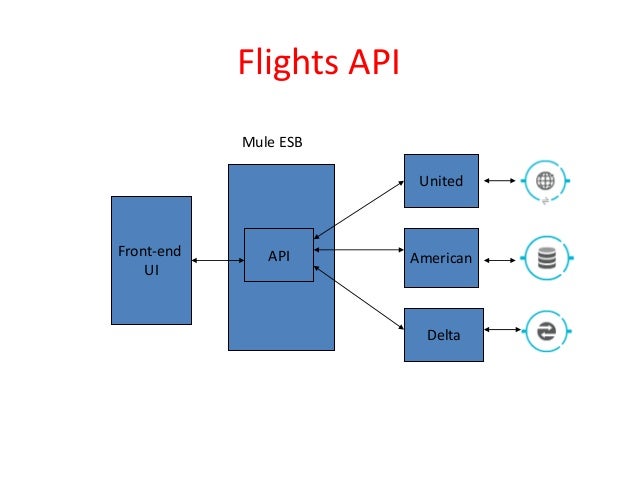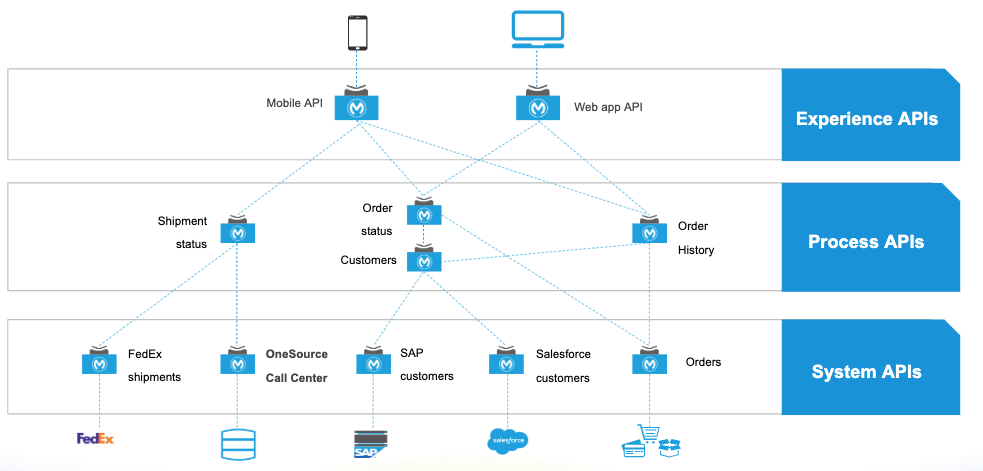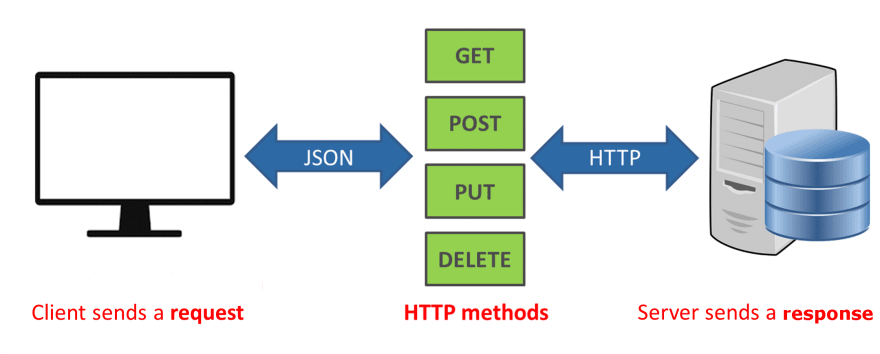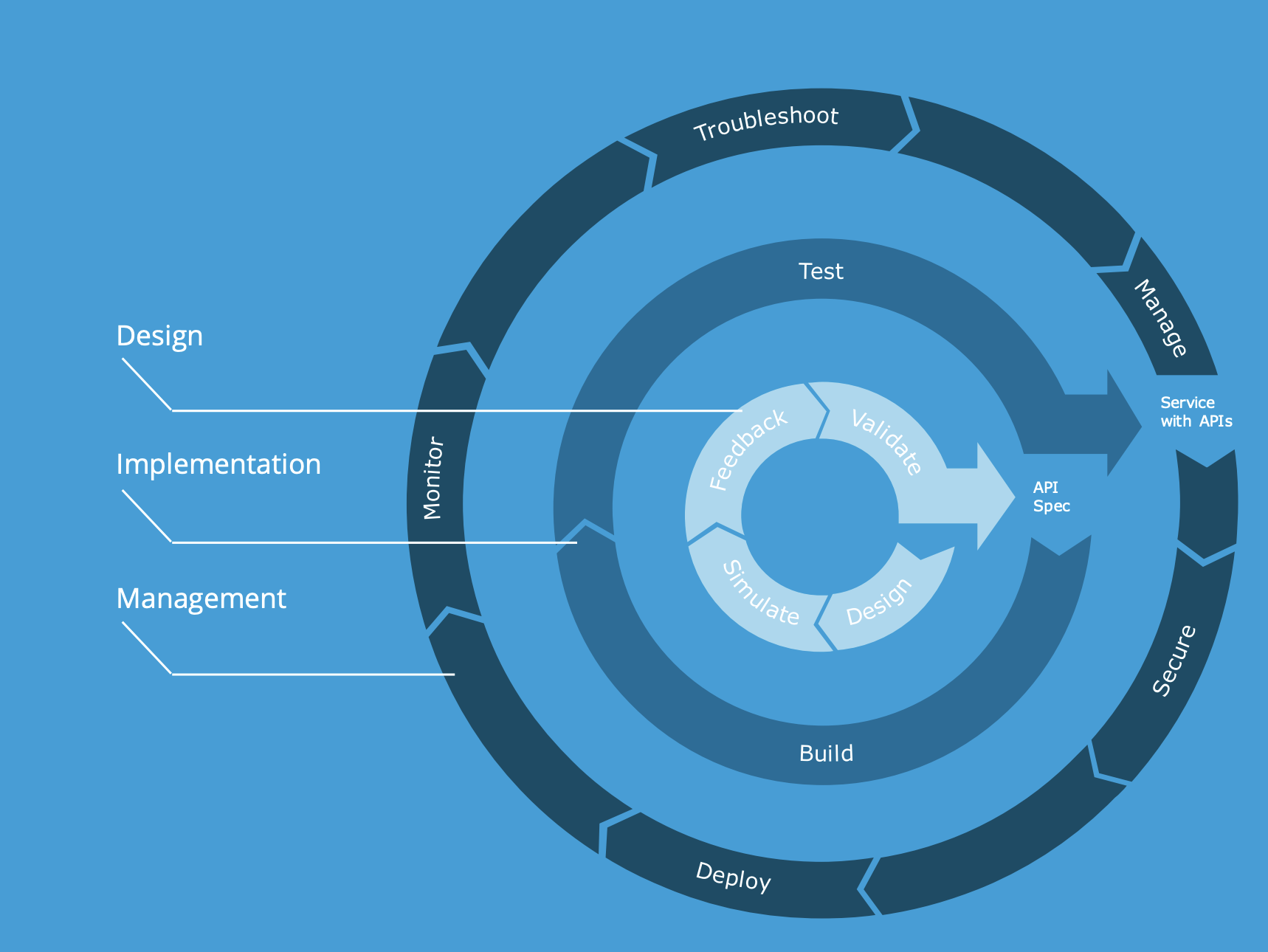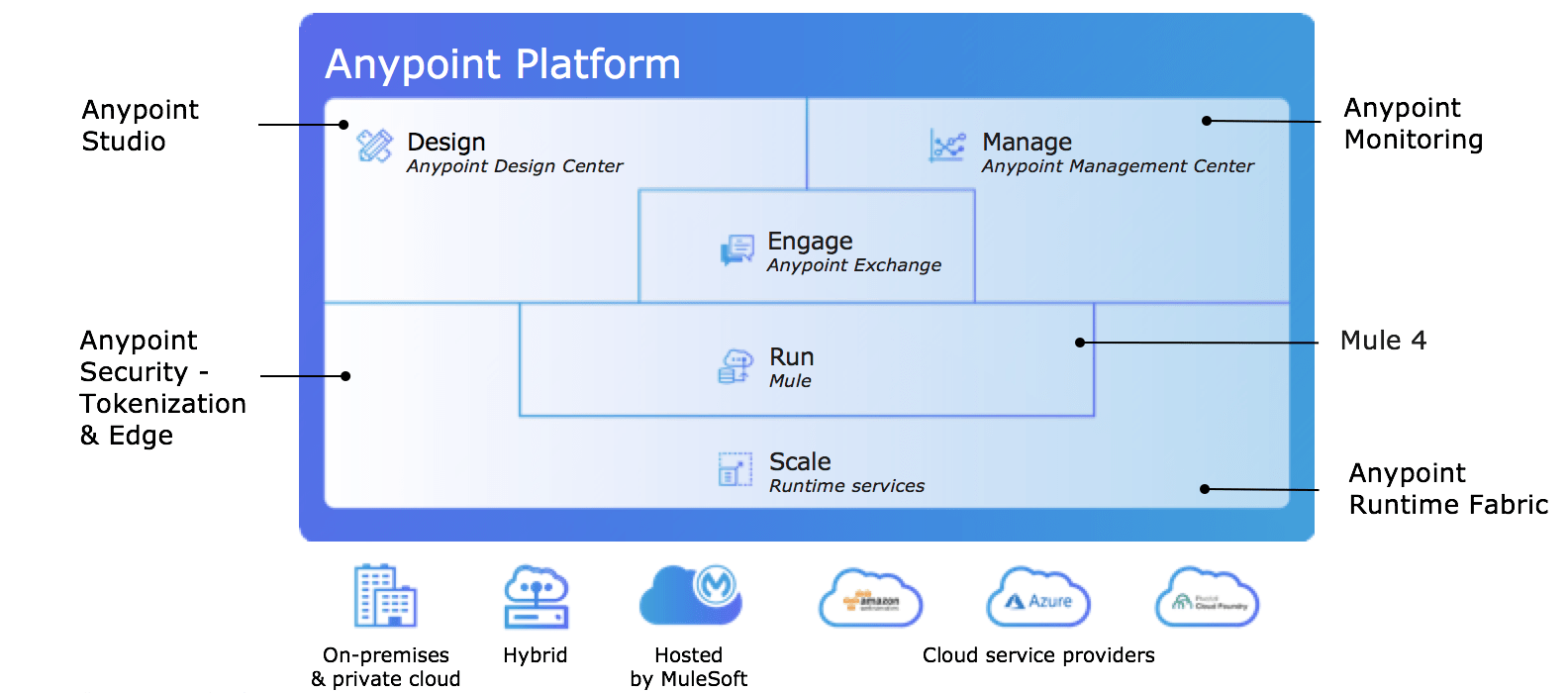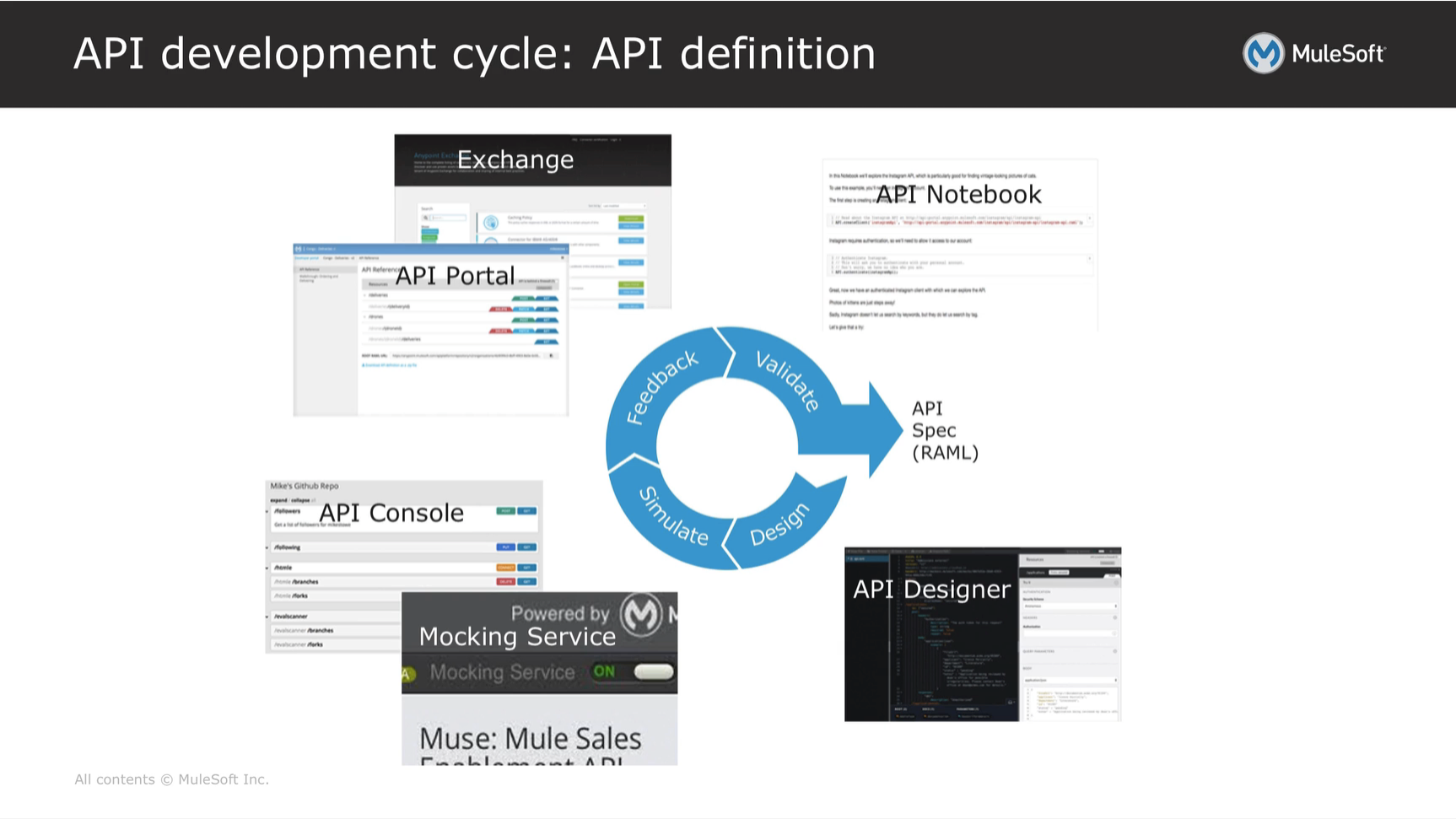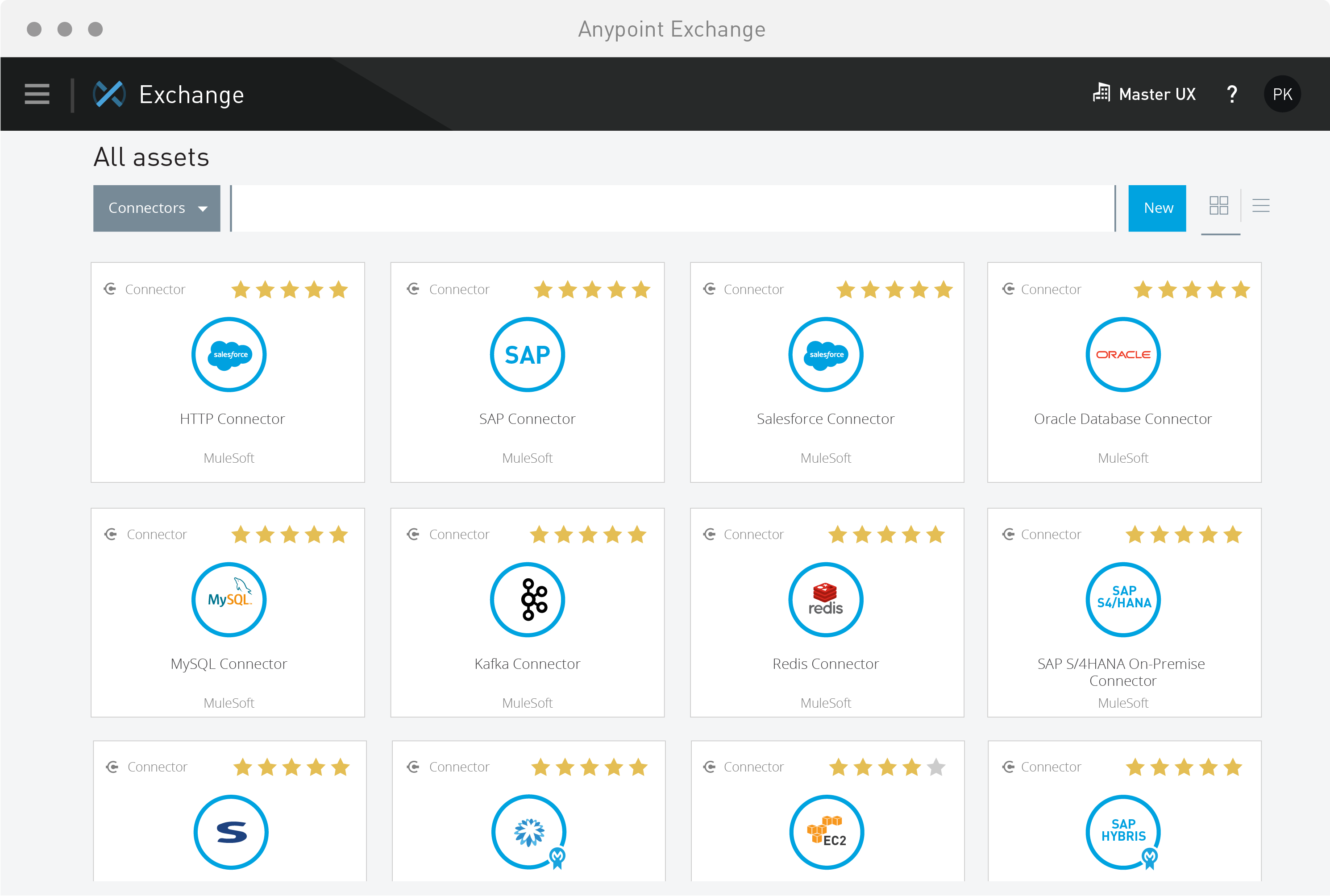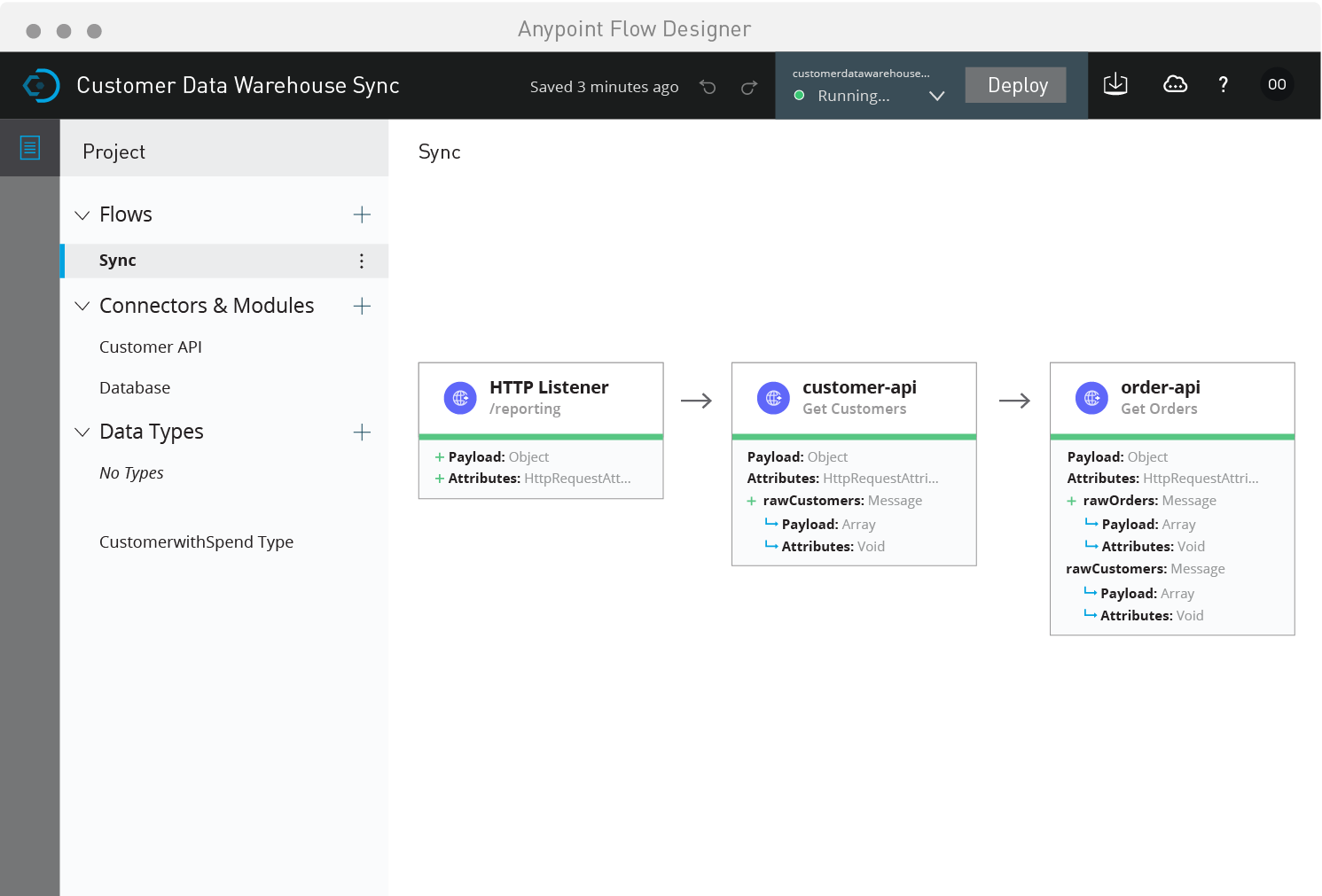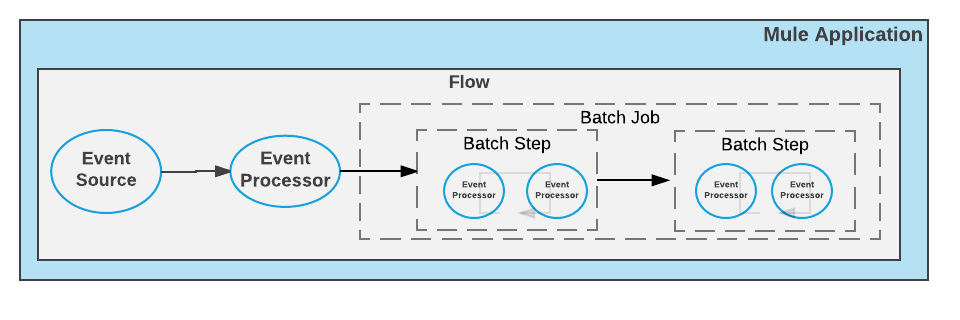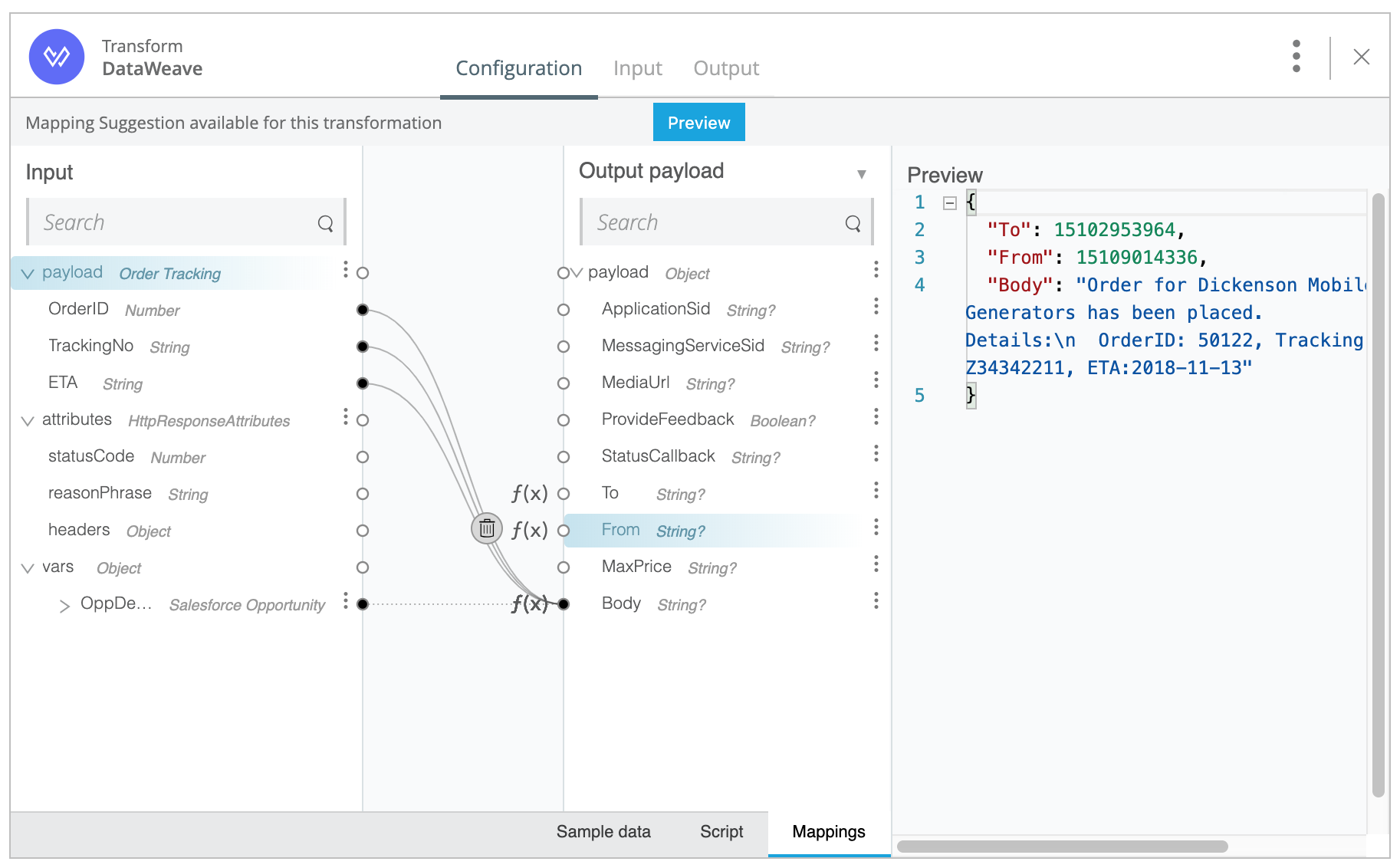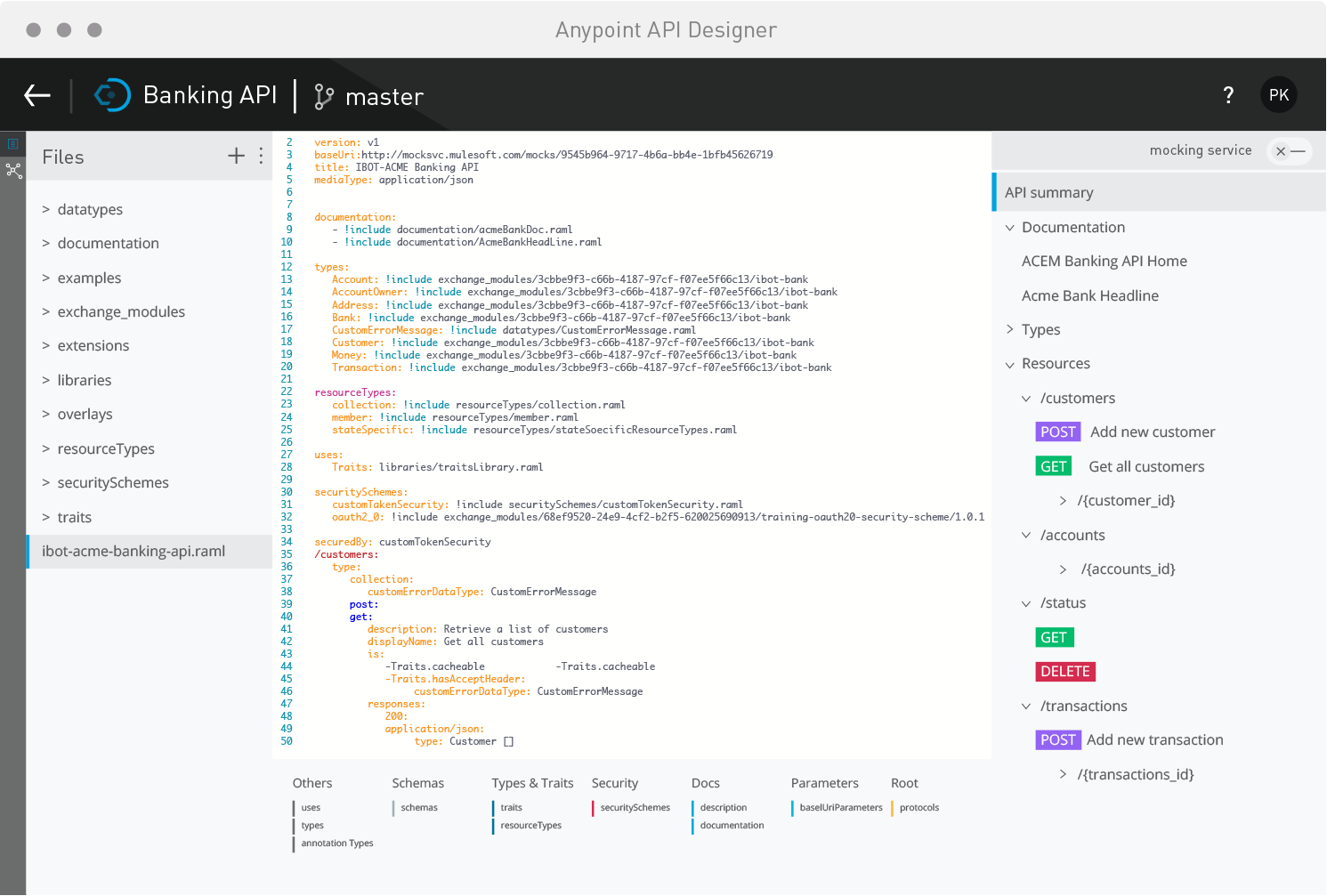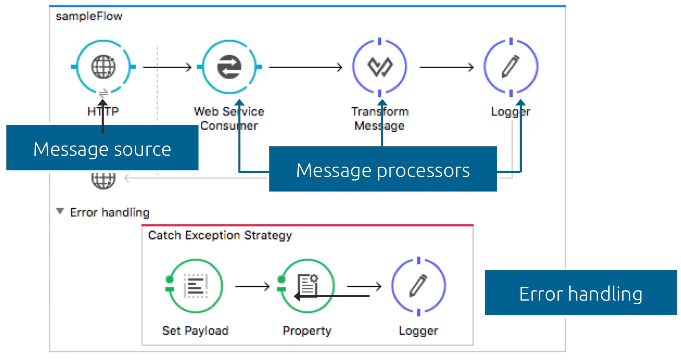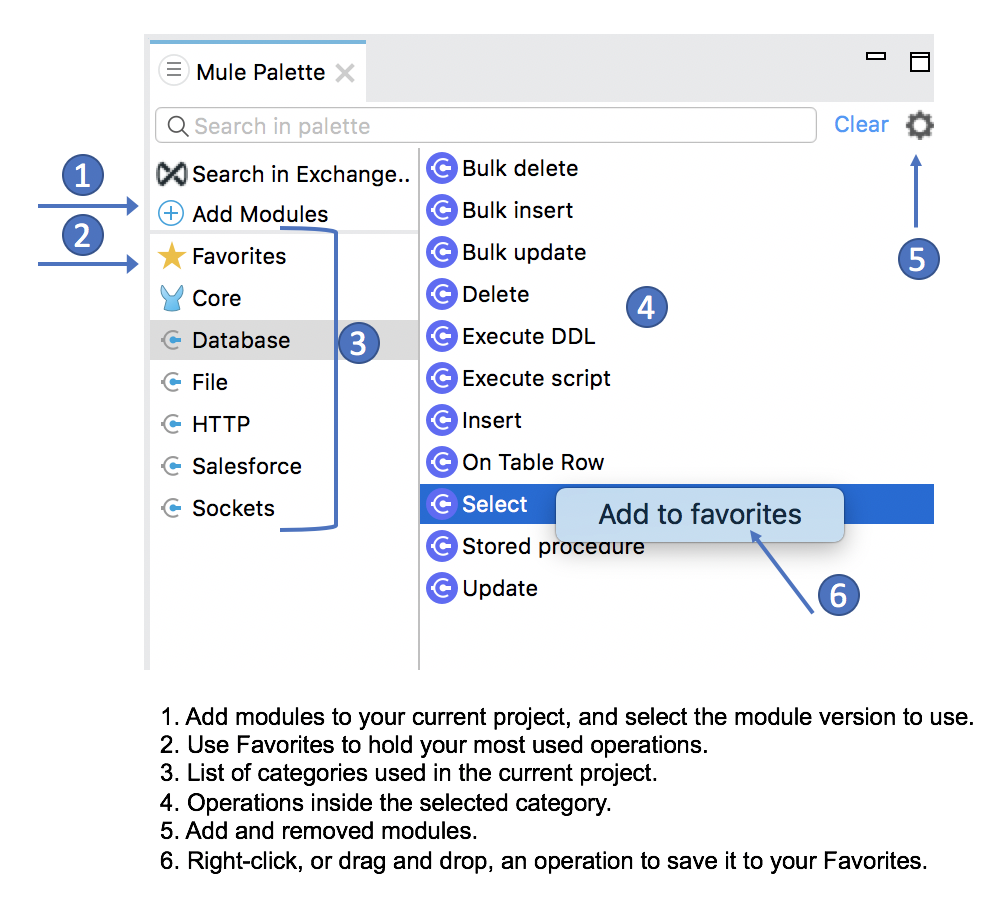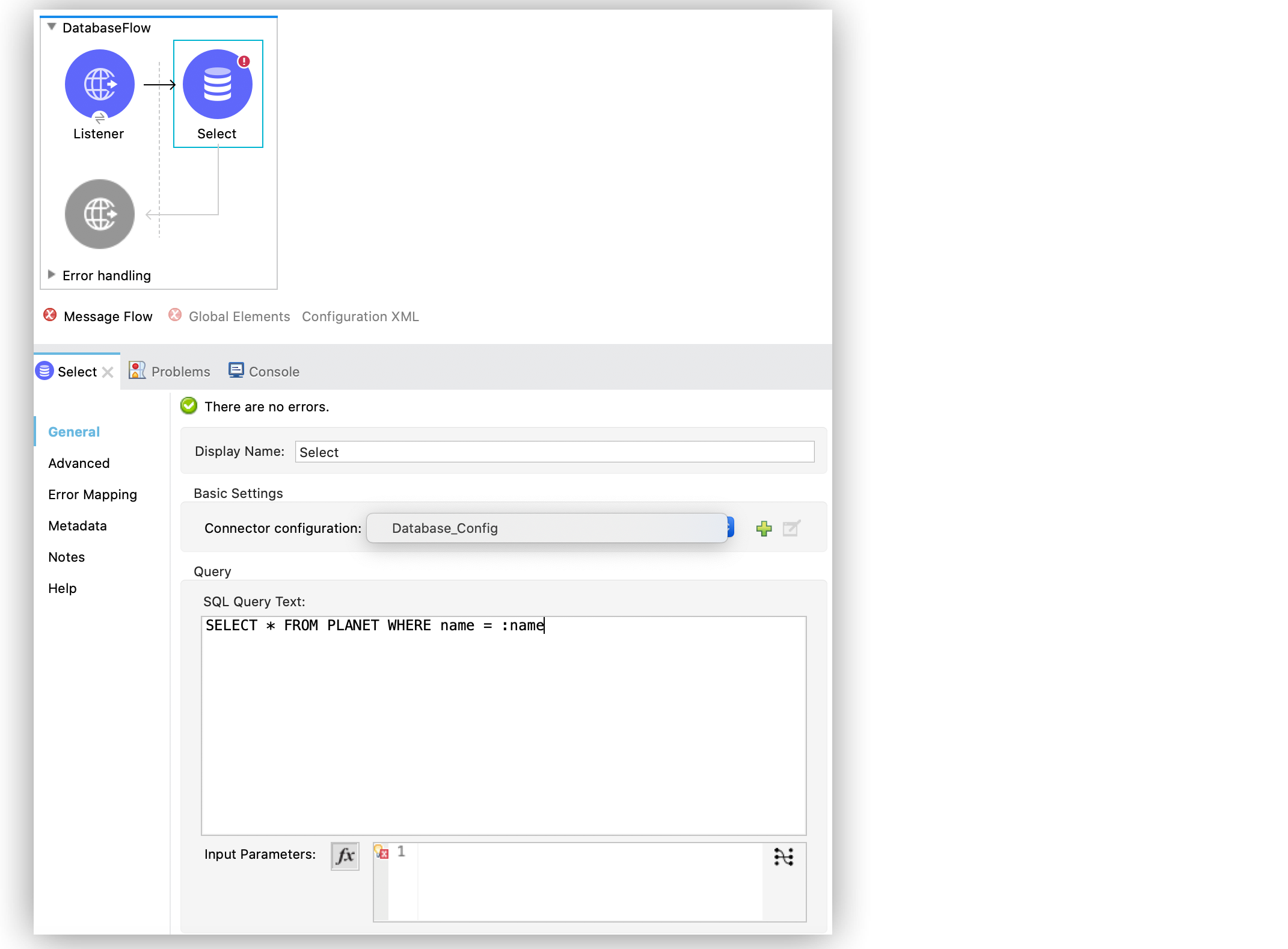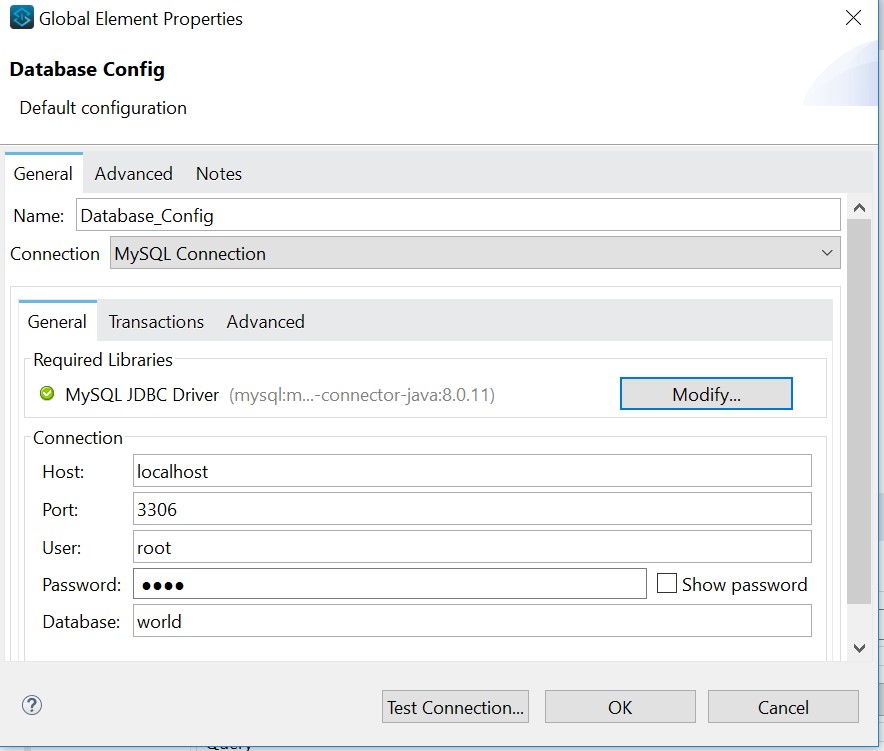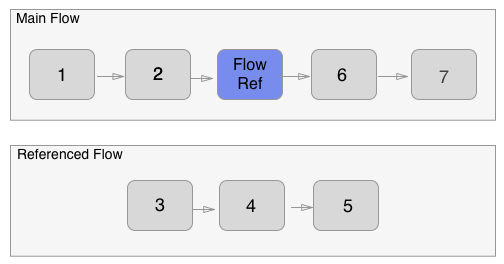Parts of the course:
- Build an application network using API-Led connectivity and Anypoint Platform
- Use Anypoint Platform
- As a central repository for discoverable and reusable assets
- To build apps to connect assets and connect systems
- To take an API through its complete development cycles
- Use Anypoint Studio to build and debug integrations and API implementations
- Connect to databases, files, web services, Saas apps, JMS queues, and more
- Add application logic and handle errors
- Handle batch data processing (process for achieves the completion of work)
- It is presented as The Mule United Airport which has 3 airlines that can deliver their flight data through several methods:
- United Airlines flight info is presented as a REST web service (as a JSON).
- Delta Airlines flight info is presented as a SOAP web service (as an XML).
- American Airlines provides access to their MySQL database (a RESTful web service is needed in order to be consumable and reusable, as well as composable).
Note: The Mule United Airport also stores data of their customers' accounts on a MySQL database and Salesforce
- Deliver an application that consumes:
- Data from a RESTful API.
- Provides access to American Flights database.
- Use a System API created by other MUA developers.
- Provides access to American Flights database.
- Data from a RESTful API.
- Design, build, deploy and manage APIs.
- Build a single API which allows users to search for flights of each of the airlines, either individualy or combined for a specific destination.
- Build Mulesoft applications using Anypoint Studio.
- Learn abour DataWeave (programming language used for data transformation, from java to XML, JSON, CSV and others ...)
- Retrieve flight data for each individual airline consuming different types of APIs (RESTful, SOAP web services)
- Create a single endpoint to retrieve all flights or filter by airlines, destination etc.
- Handle errors on Mule applications.
- Write DataWeave Transformation Scripts.
- It is an approach to design API that encourages reusable, composable (can be assemble by different combinations).
- It uses feedback from users to get better.
- System APIs: is data obtained from differents web services as SAP, Salesforce customers, and the records of orders which will be credit card numbers, items and shipping.
- Proccess APIs, with all this information, it aggregates Customers in a common endpoint it also retrieves data from customers such as order history, as well as order status, all is packaged
- Experienced APIs, is the result of all unification of data in one consumable, composable and reusable endpoint.
- It is a design approach where APIs can be easily modify. This approach means that developers does not need to create all data one more time, instead they used the available data from other APIs and build a common web service which will contain information from different sources.
-
It refers to the connection of data like a node.
-
Every new API, or node added adds more value to the network.
-
Every node is either an API that can be data retrieve from a social network such as Facebook, Twitter, SAP, Salesforce, Workday, Oracle etc, many of them sideloaded at the same time.
-
It is build to bend, not break, recomposable or built to change.
- Application Programming Interface - API
- It provides inputs and outputs of data
-
Is a way of communication between different systems, when providing a standard exchange of data.
- Web Service API. Refers to how you interact with it, it could be any type of file but ideally should implement some standard API description language sucha as RAML.
- Web service interface implemeting the API. Is the code providing the structure to the application so it implements the API
- Web Service implementation itself. Is the actual code and application.
- SOAP web services:
- Traditional, more complex.
- The communication rules are defined in an XML-based Web Services Description Language.
- RESTful web services:
- Recent, simpler type.
- Use the existing HTTP communication protocol.
-
Clients and servers exchange representations of resources using the standard HTTP Protocol.
-
Stateless: The server does not remember any client state from previous requests.
-
Clients can cache previous responses to avoid repeated network calls.
-
The HTTP request method indicates which operation should be performed on the object identified by the URL.
- Is used to retrieve a collection of companies
(GET)/companies
- Uses a query Parameter to retrieve a collection of companies based out on France.
(GET)/companies?country=France
- Uses a URI - Unique Resource Identifier to retrieve a member of the collection with the unique ID "3"
(GET)/companies/3
- It is used to create a new company, or collection of companies.
(POST)/companies with JSON/XML in HTTP body
- Deletes number 3 out of the collection of companies.
(DELETE)/companies/3
- It is used to replace the company identified by the ID "3".
(PUT)/companies/3 with JSON/XML in HTTP body.
| HTTP Methods | definition |
|---|---|
| GET | Retrieves the current state of a resource in some representation (usually JSON or XML). |
| POST | Create a new resource. |
| DELETE | Deletes a resource. |
| PUT | replaces a resource completely, if the resource does not exist, a new one is created. |
| PATCH | partially updates a resource. |
- Need to be able to specify the HTTP method, request headers, and request body
- Example tools include:
- An API portal with an API console.
- Advanced REST Client.
- Postman.
- A cURL command-line utility.
- Unsecured call to APIs does not require any credentials.
- Secured call to APIs may be secured and required authentication by some credentials or tokens.
- Often a proxy (a program that serves as gate keeper) is created to govern the access to an API.
- Can also be secured by other authentication protocols:
- OAuth, SAML, JWT, and more.
- RESTful web services return an HTTP status code with the response.
- Status code provides client feedback for the outcome of the operation (succeded, faile updated).
HTTP Status response code
- Design Center:
- Used for rapid Development.
- Exchange:
- Used to collaborate, discover assets and get stakeholder feedback.
- Managment Center:
- Used to manage parts of the application.
CloudHub: Mulesoft, self hosted environment
There are tools for every phase of the API-Design
-
API Specification Phase tools:
-
API Implementation Phase tools:
-
API Management (used to create proxy applications to govern and secured the APIs by creating Policies) Phase tools:
- When a RAML 1.0 API specification is added to Exchange, a connector is automatically created for it.
Design Center allows you to create integration application such as:
- API Specification:
- Defines how the API will behave and how it communicates with other systems and APIs.
- Fragments:
- Compose snippets that can easily be reused accross multiple APIs
- Mule Apps:
- Design a Mule integration flow.
- It includes 3 applications
| Application | Purpose |
|---|---|
| Flow Designer | Web app for building integration apps that connect systems and consume APIs |
| API Designer | Web app for designing documenting, and mocking APIs |
| Anypoint Studio | Desktop IDE for implementing APIs and building integration applications |
Flow Designer and Anypoint Studio are Java based applications, using the Spring Framework; used for creating Mule applications with similar approaches.
- Flow Designer is web based application for creating Mule applications used to assemble integrations applications using visual connectors and other assets from Exchange and publishes them to CloudHub.
- Anypoint Studio is an IDE used to create Mule applications by adding also components and proccesors to flows, which create XML code.
- This apps cna be published anywhere or in Mule Runtime.
- Mule Runtime is a lightweight Java-based enterprise service bus (ESB) and integration platform that allows developers to connect apps together quickly and easily, enabling them to exchange data.
- Acts as a transit system for carrying data between apps (the Mule).
- Can connect all systems including web services, JMS, JDBC, HTTP and more.
- Decouples point to point integrations by having all (non-Mule) apps talk to the bus (to a Mule Runtime) instead of directly to each other.
- Enforces policies for API governance
- Mule Application is a set of XML files that can have multiple flows. A Mule application is a sequence of Mule event procesors.
-
Mule Event Processors are organized on another processor called the flow.
-
Flow is the unique thing that can be excecuted on a Mule 4 application, which includes 3 main areas:
- A source.
- Controls how the flow is trigger.
- Process area.
- Determines what it does.
- Error handling.
- Handles the error.
- A source.
- Source initiates execution of the flow.
- Data and metadata passed to the source is subsecuently enrich, process and transformed.
- Process
- When a Mule application is created in Design Center:
- The application is deployed to a MuleSoft-hosted Mule runtime (called a CloudHub worker).
- It is a dedicated instance of Mule that runs a single application
- has different memory capacity and power.
- When a Mule application is triggered, a data structure is created and stored internally
- Mule event is the data structured, has 2 main elements:
- Mule Message , contains 2 elements:
- Attributes - metadata, contains the parameter and headers.
- Payload - actual data you will like to process.
- Variables
- Mule Message , contains 2 elements:
- Mule event is the data structured, has 2 main elements:
-
DataWeave 2.0 is programming language used to transform data either from XML to JSON, Java, CSV and others.
-
Transformation of data on Flow Designer is done by using the Transform component.
Note: Using Transform component (DataWeave) to transform one source of input data, to another format of output data is as follows: Example format of input data:
[
{
"ID": 1,
"code": "rree0001",
"price": 541,
"departureDate": "2016-01-20T00:00:00",
"origin": "MUA",
"destination": "LAX",
"emptySeats": 0,
"plane": {
"type": "Boeing 787",
"totalSeats": 200
}
},
{
"ID": 2,
"code": "eefd0123",
"price": 300,
"departureDate": "2016-01-25T00:00:00",
"origin": "MUA",
"destination": "CLE",
"emptySeats": 7,
"plane": {
"type": "Boeing 747",
"totalSeats": 345
}
]Example format of output data, using Transform component (DataWeave):
[
{
"airline": "United",
"flightCode": "ER38sd",
"fromAirportCode": "LAX",
"toAirportCode": "SFO",
"departureDate": "May 21, 2016",
"emptySeats": 0,
"totalSeats": 200,
"price": 199,
"planeType": "Boeing 737"
},
{
"airline": "Delta",
"flightCode": "ER0945",
"fromAirportCode": "PDX",
"toAirportCode": "CLE",
"departureDate": "June 1, 2016",
"emptySeats": 24,
"totalSeats": 350,
"price": 450,
"planeType": "Boeing 747"
}
]*Note: Observe that flightCode from the * output *it is with upper case, also data structure is simplier to read and consume, less nested as in the input.
- Anypoint Exchange:
- Acts as a central repository for assets so they can be discovered and reused.
- Flow Designer:
- Is a visual way of construction for integration applications.
- Mule runtimes:
- Is a Java based service bus and integration platform that allows connection of NonMule applications carrying data to Mule applications for integration.
- Also Mule runtimes can be hosted on CloudHub workers, or Customer-Hosted in the cloud or in Server of the client.
- Is a Java based service bus and integration platform that allows connection of NonMule applications carrying data to Mule applications for integration.
- DataWeave 2.0:
- Is the language that allows APIs on different formats that contain data either as Java objects, JSON, XML, CSV and other types of data to be transformed on other types of data or rearrange to be consumed.
- Can also access, query, and transform Mule 4 event data.
- Spec driven development: Is a process where your application is built in two-distinct phases:
- The creation of a spec (the design phase).
- Development of code to match the spec (the development phase).
- This API Specification is created using a standarizing API description language (RAML).
- API designer features an embedded code editor for the design of the API Spec to write RAML code.
- API Console and Mocking Service serves as a Simulation state where you can try (using example data) and visualize the endpoints, as well as different HTTP query methods defined before on the API Designer.
Note: When the API Specification is ready to be share to a broader audience, can be publish to Exchange- Exchange is a web repository for discoverable assets such APIs, connectors and more, the API Spec designed and tested on the Desgin and Simulates phases, can be published here so more people can try it in order to get feedback.
- API Portal is a web page intended for developers to access to API Spec to test it and provide feedback as well as visualize it graphically.
There are several approaches available, for designning APIs.
- Hand coding, it was the initial approach for developers to build the API.
- API blueprint
- Swagger, OpenAPI Spec.
- RAML, is open source, supports inheritance and easy to read human syntaxis.
- Is used to define the API Specification.
- Is simple, structured, and succint (clear and short) way of describing RESTful APIs.
- It is entirely modular.
- Encourages reuse.
- Can be used to autogenerate documentation, mock endoints, and intefraces for API Implementation
- Is based on YAML.
- Resources are all the nodes that begin with a slash
/something- they are obejcts identified by the web serivec UTL that you want to act upon using HTTP method used for the request.
- Any methods and parameters nested under a resource belong to and act upon that resource.
- Nested Resources are used to select members from a collection (URI parameters)
- URI parameters are enclosed in curly braces
{}
- URI parameters are enclosed in curly braces
#%RAML 1.0
version 1.0
title: American Flights API
/flights:
get:
post:
/{ID}:
get:
delete:
put:
responses:
200:
body:
application/json:/{ID}is the nested resource definition, which is designed to retrieve a single flight out of the list of flights.
- File Browser, to search files or paths.
- Editor.
- Shelf, adds code depending on the context you are writting code on the Editor or where your cursor is located.
- API Console, to visualize the autogenerated documentation of HTTP methods added to the API Spec using RAML.
#%RAML 1.0
title: API_Spec_American_Flights_API
# Rsource /flights
/flights:
# GET method
get:
# queryParameters used on the URL /flights?destinitation=SFO
# destinitation=LAX
# destinitation=CLE
queryParameters:
destination:
required: false
enum:
- SFO
- LAX
- CLE
# POST Method
post:
# Nested Resource, used on the URL to identify a single member (flight) from a collection of flights
# /flights/3
# /flights/50
/{ID}:
#GET Method
get:
# POST method
post:
# DELETE method
delete:
- API Console is graphical way of visualizing the API and the different HTTP Methods
- It is available through:
- API Designer - so the API Designer can test.
- API Portals in Exchange - so users/developers can test it.
- Mocking Service is a test URL to share links for stakeholders (developers).
- This allows to make calls to the mocked API.
- This is used to define for requests and responses.
- Responses must be of one or more HTTP status codes.
- For each response, specify posible return data types along with descriptions and examples.
/{ID}:
get:
responses:
# HTTP status succes code 200
200:
# body definition
body:
# media type of application json
application/json:
# return data type
type: AmericanFlight
# inline definition of return data
examples:
output:
ID: 1
code: ER38sd
price: 400
departureDate 2017/0726
origin: CLE
destination: SFO
emptySeats: 0
plane:
type: Boeing 737
totalSeats: 150- Specify the posible request data types along with descriptions and examples.
/flights:
get:
post:
# body definition
body:
# media type of application json
application/json:
# Request data type American Flight
type: AmericanFlight
# inline definition of request data
examples:
input:
code: ER38sd
price: 400
departureDate: 2017/07/26
origin: CLE
destination: SFO
emptySeats: 0
plane:
type: Boeing 737
totalSeats: 150
- There are 2 types of facets you can use to specify example data:
- example represents a single instance of the data.
type: User example: name: Bob lastname: Marley
- examples represents multiple instances of data as a map of key-value pairs
type: User examples: person1: name: Paul lastname: McCartney person2: name: Lady lastname: Gaga
- Use Fragments of APIs that are RAML code that can be discovered on Exchange and or imported to the API Specification (RAML) as RAML files
- Such files encourages reusable fragments which can be:
- Data types, examples, traits, resource types, overlays, extentions, security schemes, documentation, annotations and libraries
- Fragments can be stored in:
- Different folders and files within a project.
- Seperate API fragment project in Design Center.
- In a seperate fragment in Exchange.
- Such files encourages reusable fragments which can be:
Adding a data type on API designer
Once imported the Training American Flight data type and Training American Flights Example RAML Framents to the Explorer files within API designer:
- Add the following data type at the begining of the ```Root file``-API specification RAML
API Specification RAML
#%RAML 1.0
title: API_Spec_American_Flights_API
#This is added to import from within the files of the Explorer using the special word !include
types:
AmericanFlight: !include /exchange_modules/68ef9520-24e9-4cf2-b2f5-620025690913/training-american-flight-data-type/1.0.1/AmericanFlightDataType.raml
/flights:
get:
queryParameters:
destination:
required: false
enum:
- SFO
- LAX
- CLE- Specify Response to the /flights:get method to return an array of AmericanFlight objects
- responses > 200 > body > application/json > type > AmericanFlight
/flights:
get:
queryParameters:
destination:
required: false
enum:
- SFO
- LAX
- CLE
responses:
# response for the request 200 success status code
200:
body:
application/json:
type: AmericanFlight[]- Add an example response for the /flights:get method
- Locating the path for
AmericanFlightsExample.ramlthat contains an example of flights to respond. exchange_modules/training-american-flights-example/1.0.1/AmericanFlightsExample.raml
#%RAML 1.0 NamedExample
value:
-
ID: 1
code: ER38sd
price: 400
departureDate: 2017/07/26
origin: CLE
destination: SFO
emptySeats: 0
plane:
type: Boeing 737
totalSeats: 150
-
ID: 2
code: ER45if
price: 540.99
departureDate: 2017/07/27
origin: SFO
destination: ORD
emptySeats: 54
plane:
type: Boeing 777
totalSeats: 300
- In this step should add the response of 2 flights:
/flights:
get:
queryParameters:
destination:
required: false
enum:
- SFO
- LAX
- CLE
responses:
200:
body:
application/json:
type: AmericanFlight[]
#examples that represents multiple instances of data
examples:
output: !include /exchange_modules/68ef9520-24e9-4cf2-b2f5-620025690913/training-american-flights-example/1.0.1/AmericanFlightsExample.raml- Specify the /{ID}:get method to return an AmericanFlight object
- In the editor, indent the /{ID} resource get method.
- In the shelf, click responses > 200 > body > application/json > type > AmericanFlight.
/{ID}:
get:
responses:
200:
body:
application/json:
type: AmericanFlight- Define an example response for the /{ID}:get method in new folder
- Create a folder at the main path, named it
examples - in pc local files, search for
Student_files\resources\examples\AmericanFlightExample.ramland this should contain information for 1 flight. Now the body response for /{ID} should be accessible from API Designer console
- Create a folder at the main path, named it
- When trying it should retrieve the same flight object since it was hard coded even though you use different URI parameters.
- Specify the /flights:post method request to require an AmericanFlight object
- In the editor, under /flights post method add the body > application/json > type: AmericanFlight
post: body: application/json: type: AmericanFlight
- Create a new file within API Designer
examples/AmericanFlightNoIDExample.ramldeleting the ID key value pair which should have the same content asexamples/AmericanFlightExample.ramlas the following code: ./examples/AmericanFlightNoIDExample.raml
#%RAML 1.0 NamedExample value: # Deleted "ID" key-value pair code: ER38sd price: 400 departureDate: 2017/07/26 origin: CLE destination: SFO emptySeats: 0 plane: type: Boeing 737 totalSeats: 150
- Adding the the instance
examplestreats as the input type of data.
post: body: application/json: type: AmericanFlight examples: input: !include examples/AmericanFlightNoIDExample.raml
- Specifying an example response for the /flights:post method
- adding response > 201 > body > application/json > example > input: !include ./path_of_the_file
post: body: application/json: type: AmericanFlight examples: input: !include examples/AmericanFlightNoIDExample.raml responses: 201: body: application/json: example: message: Flight added (but not really)
- When publishing the API Specification on Exchange an API Portal is created so it allows:
- Get feedback from developers on ussability and functionality.
- Either public the API Spec for internal developers or public for external developers.
- API Portals are automatically created for REST APIs added to Exchange
- An API Console is also added for consuming and testing APIs within the same browser without a REST Client application.
- An automatically generated API endpoint that uses mocking service to allow the API to be tested without having to implement it.
Tasks / Requirements
-
Create a RAML 1.0 specification.
-
Add a method to retrieve customer accounts.
- Inputs:
- The person or system requesting the data
- An optional account type to fetch personal or business accounts
- An optional name to identify the accounts belonging to a particular customer
- Outputs:
- A JSON array of accounts; each account contains:
- ID, a positive integer identifier
- Name, a string value identifying either the name of the individualor company
- Type, either business or personal
- Address, a CSV string value containing the address,e.g.,
12345 GreenSt,Boulder,Colorado,82433,USA - Air Miles, a positive integer value indicating the air miles accrued
- Creation Date, a timestamp identifying the date and time the account was created
- A JSON array of accounts; each account contains:
- Inputs:
-
Add a method to create customer accounts.
- Inputs:
- The person or system creating the data
- A JSON array of accounts; each account contains:
- Name, a string value identifying either the name of the individual or company
- Type, eitherbusinessor personal
- Address, a CSV string value containing the address
- Air Miles, a positive integer value indicating the air miles accrued
- Outputs:
- Success:
- A literal JSON object containing:
{"message": "Accounts created"}
- A literal JSON object containing:
- Success:
- Inputs:
-
Document your specification where appropriate.
-
Create types and examples where necessary.
-
Organize your specification in folders and files.
-
Publish to Exchange.
#%RAML 1.0 title: Customer_accounts # types are the definition of what types of data are the output going to throw types: Account: !include dataType/accountDataType.raml # Defining the Resource /accounts /accounts: # Method for retrieving data: GET get: # Query Paramters: used to filter a condition queryParameters: # 2. optional account type to filter accountType: required: false # enum: list of conditional constants on the request enum: - personal - business # 3. optional name belonging to a particular customer name: required: false # 2. Outputs of the the GET request responses: # 200 if it is a Successful call or request to the API # 200: is also metadata from the server 200: # body: what will be contained when requested data body: # type of output data application/json: # type: Account[] refers to the structure of data that will be the output taking a data type in count type: Account[] # examples: defines that the instance of data whill be multiple objects examples: # output is the keyword to tell what the data of the body will contain output: !include accounts/accountsExampleResponseGET.raml post: description: Create accounts #headers: will be the metadata to identify the person or system trying to modify data headers: # user_id is a requiered field in order to acces the operation user_id: body: application/json: type: Account example: input: !include accounts/accountExamplePost.raml responses: 201: body: application/json: example: message: Accounts created
-
Build of API implementation: The API Specification (RAML) created before, can be used in this stage to build the API implementation.
-
Testing the API implementation: a rest client like Adavanced REST Client can be used to call the API implementation, also cna be used Postman as well as others.
- Later in this module the following topics will be covered.
- Using Anypoint Studio to build, run, and test Mule applications.
- Use a connector to connect to databases.
- Use the graphical DataWeave editor to transform data.
- Create RESTful interfaces for applications from API specifications.
- Connect API interfaces to API implementations.
- Syncronize changes to API specifications between Anypoint Studio and Anypoint Platform.
- Later in this module the following topics will be covered.
-
Mule applications receive events, process them, and route them to other endpoints.
-
Mule applications accept and process a Mule event through a series of Mule events processors plugged together in a flow with
- Mule event source defines how the flow will be triggered
- Mule event processor specify how to transform, filter, enrich, and process the event data.
- Mule event contains:
- Mule message object
- Attributes: contain metadata such as the ones found at the header of an http request, like http method, query parameters and so on.
- Payload: will contain the actual data you are about to process and that the end user can visualize.
- Mule variable object
- Mule message object
-
Anypoint Studio
- Based on the Eclipse IDE, allows you to build Mule applications either with graphical view interface or an XML editor.
- XML then can be executed and deployed in the Mule Runtime.
- Include pre-built functionality which allows you to connect to all types of APIs (REST, SOAP), protocols (HTTP, FTP, SMTP & more) and popular services (Salesforce, Workday & more).
- Allows you to transform data to structures
- Allows you to sync, edit and upload API Specifications with Anypoint Platform
- Can also run, debug and deploy Mulesoft applications
- Be able to create common integration patterns
- Utilize Maven Repositories for continuous build processes
Anypoint Studio User Interface perspective of Design
- Has 3 perspectives:
- Debugging perspective.
- API development perspective.
- Design perspective.
- Canvas: is meant to show the Mule flow of an application.
- Can display a graphic view of the application flow, or an XML file editor.
- Package Explorer: used to display project files.
- Mule Palette: display the modules added to project and each one with their processors
- Console: display important information like:
- Canvas: is meant to show the Mule flow of an application.
- All are customizable.
Anatomy Visual Flow
- As you confiigure the flow, XML code is generated in the Configuration view Tab
- Mule applications are built using the processors from the modules added to the Palette.
- It is used to test applications without leaving Anypoint Studio.
- Helps viewing the messages generated when the project is deploying and running.
- A message of Status DEPLOYED means you can start testing the Mule application.
- A message of Status FAILED you can scroll up in the console to check error messages
- Based on the Eclipse IDE, allows you to build Mule applications either with graphical view interface or an XML editor.
-
It uses a
Database Connectorthat can connect to almost any JDBC relational database.Anypoint Studio Palette
-
There is a global configurations elements view under the canvas
- Its purpose to create reusable connector configuration for most of the modules that have connections
- Contain a shared configuration settings for the modules processors:
- When you add the Database module you will be able to perform operation on the data that contain in the various tables of the database.
- For each operation you will need to specify:
- For this, it is needed to create a global configuration element to perform a SELECT query to a MySQL database
- Test Connection to verify the correct functionality.
-
The purpose is to transform the
media typethat came from the query to the database to a different standard format in order to be consumed. -
It is performed by a
Transform Messageconnector found at the Mule Palette.Transform Message processor from the Mule Palette
-
Transform Message transforms data to different types using a transformation language named DataWeave 2.0.
- It is provided with a graphical interface with payload-aware development
- DataWeave Playground lets developers mock data transformations based on an input payload outside Anypoint Studio in a web browser.
- Offers a tutorial
- https://developer.mulesoft.com/learn/dataweave/ DataWeave Playground
- It uses output metadata type to add in order to map the input payload to a different one Input data queried from MySQL Database
%dw 2.0 output application/java --- [{ ID : 32, code1 : "consequatur,", code2 : "velit", airlineName : "dolorem", toAirport : "magni", fromAirport : "quia", takeOffDate : |2005-05-16|, price : 37.13, planeType : "enim", seatsAvailable : 83, totalSeats : 9, }, { ID : 12, code1 : "nesciunt.", code2 : "occaecat", airlineName : "sint", toAirport : "mollit", fromAirport : "dolorem", takeOffDate : |2019-11-06|, price : 7.67, planeType : "non", seatsAvailable : 74, totalSeats : 98, }]
DataWeave 2.0 language within Transform Message dialogue box
%dw 2.0 output application/json --- payload map ( payload01 , indexOfPayload01 ) -> { ID: payload01.ID, code: (payload01.code1 default "") ++ (payload01.code2 default ""), price: payload01.price default 0, departureDate: payload01.takeOffDate as String default "", origin: payload01.fromAirport default "", destination: payload01.toAirport default "", emptySeats: payload01.seatsAvailable default 0, plane: { "type": payload01.planeType default "", totalSeats: payload01.totalSeats default 0 } }
JSON format after transformation from Java to JSON using DataWeave 2.0 language from the Transform Message
[ { "ID": 1, "code": "rree0001", "price": 541, "departureDate": "2016-01-19T18:00:00", "origin": "MUA", "destination": "LAX", "emptySeats": 0, "plane": { "type": "Boeing 787", "totalSeats": 200 } }, { "ID": 2, "code": "eefd0123", "price": 300, "departureDate": "2016-01-24T18:00:00", "origin": "MUA", "destination": "CLE", "emptySeats": 7, "plane": { "type": "Boeing 747", "totalSeats": 345 } } ]Note: the key-value pairs from planeType and totalSeats of the input had been reused and transform to a nested JSON object under the key "plane" of the output, thanks to DataWeave 2.0 and Transform Message Mule event proccessor
-
Once having the core functionality of the Mule application implemented, now it has to be exposed as RESTful web service.
- RESTful interface for an application: will have listeners for each resource
/method defined by the APIGET: /flightsPOST: /flights/{ID}DELETE: /flights/{ID}PUT: /flights/{ID}
-
When querying a resource not develop the following error is the output from a REST Client (Advanced REST Client - ARC, Postman):
Error example on of a non developed listener endpoint
-
Example error on Advanced REST Client when requesting ID 3 from the Flights with GET method at
http://localhost:8081/flights/3GET /flights/3 HTTP/1.1 Host: localhost:8081 -
To solve this issue we must create an endpoint with all the previous components which were:
- Mule event Source: HTTP Listener
- Mule event processors: SELECT by ID from database connector, Transform Message (transform the output data from db on Java object format to JSON) using DataWeave 2.0.
-
Steps for implementing an URI Parameter based endpoint:
- Create a new flow with:
- HTTP Listener, with path set to
/flights/{ID}. - SELECT processor with SQL query to ID
SELECT * FROM american WHERE ID = 1(this will always query the first element fromdb). - Transform Message processor, to set a valid format for the succesful response of the query from Java Object format to JSON.
- HTTP Listener, with path set to
- Transform message output metadata should be define to the previously american_flights_json ( outputs only 1 flight wihtin an array) in order to display it with nested JSON format like this one when deployed and query it from a REST client:
[ { "ID": 1, "code": "rree0001", "price": 541, "departureDate": "2016-01-19T18:00:00", "origin": "MUA", "destination": "LAX", "emptySeats": 0, "plane": { "type": "Boeing 787", "totalSeats": 200 } } ]- In order to add the logic to query the requested ID dynamically SQL Query Text and Input Parameters from the SELECT processor should be modify to:
- SQL Query Text:
SELECT * FROM american WHERE ID = :ID
- Input Parameters
fxon:
Note: accessing to the Mule Message > Attributes > uriParams from the input Tap allow us to access the URI Parameter we need for the ID. 4.- Requesting any ID using a REST client to the path, for example:{'ID': attributes.uriParams.ID}
http://localhost:8081/flights/3; would give us any ID and its data we want. Example output data:
[ { "ID": 3, "code": "ffee0192", "price": 300, "departureDate": "2016-01-19T18:00:00", "origin": "MUA", "destination": "LAX", "emptySeats": 0, "plane": { "type": "Boeing 777", "totalSeats": 300 } } ]
- Creating another flow to POST or create new flights, will be using the similar configuration:
- HTTP Listener-Mule event source
- Steps to create enpoint for POST flights:
- Drag and drop, in a new flow; an HTTP Listener
- Flows' display Name can set to POST_flights for easy identification.
- HTTP Listener connector configuration should be set to the existing HTTP_Listener_config
- Set Path must be: ``/flights`
- within HTTP Listener, on the Advanced tab, Allowe methods must be set to
POST
- Add to the flow Set Payload processor, this will output to the REST Client console a generic and hard coded message of a flight created.
- within general Set Payload tab > settings > value >
fx(set to literal mode):{"message": "Flight added (but not really)"}
- within general Set Payload tab > settings > value >
- Requesting POST method on REST client to the defined path (
/flights), results on a succesful operation 200 with the response message defined before.
- Drag and drop, in a new flow; an HTTP Listener
- Create a new flow with:
- RESTful interface for an application: will have listeners for each resource
-
APIKit and API Specification (RAML) will be used to create automatically the RESTful interfaces (endpoints, eg. GET,POST /flights and GET /flights/{ID}).
- Is an open-source toolkit that includes an Anypoint Studio plugin
- The Anypoint Studio APIKit plugin can generate an interface automatically from a RAML API definition
- It can be used for generating Mule flows for each of the message and API Specification and stored them in a new Mule configuration file.
- It creates a flow for the APIKit Router and Console
- APIKit Router: is the main entry point to call a Mule application
- APIKit Console: is used for testing the application just like it is on Exchange and on API Designer.
- The generated flows represent the RESTful API interface and can be hooked to the implementation hub using Flows Reference Processors.
Using the APIKit Router to import the API Speficiation from Exchange and build the API Interfaces (GET, POST /flights endpoint)
- At the File Explorer, right click on the current project > Manage Dependencies > Manage APIs
- Add new dependency ➕ > From Exchange
- Search for
American Flight APIand click on add, select version 1.0.1 Apply and Close- When asked to scaffold selecte
YesNote: there will be added new files to the project including./APIKitwith several files as shown here:
- Examining the generated
american-flights-api.xmlfile we cna see 4 flows:-
delete: /flights/{ID}
-
get: /flightsTransform Message output preview%dw 2.0 output application/json --- [ { ID: 1, code: "ER38sd", price: 400, departureDate: "2017/07/26", origin: "CLE", destination: "SFO", emptySeats: 0, plane: { "type": "Boeing 737", totalSeats: 150 } }, { ID: 2, code: "ER45if", price: 540.99, departureDate: "2017/07/27", origin: "SFO", destination: "ORD", emptySeats: 54, plane: { "type": "Boeing 777", totalSeats: 300 } } ]
-
get: /flights/{ID}Transform Message Preview%dw 2.0 output application/json --- { ID: 1, code: "ER38sd", price: 400, departureDate: "2017/07/26", origin: "CLE", destination: "SFO", emptySeats: 0, plane: { "type": "Boeing 737", totalSeats: 150 } }
-
post: /flights Transform Message Preview
%dw 2.0 output application/json --- { message: "Flight added {but not really}" }
-
- Examine the main flow and it's HTTP Listener
- HTTP Listener: in the Listener properties view, notice that the connector configuration is the existing HTTP_Listener_config and that the path is set to ``/api/*` (when clicking on the connector configuration ➕, should see the same port 8081 used as the HTTP Listener created previously). Note: The * is a wildcard allowwing any characters to be entered after the /api/.
- Removing the Listeners from the
training4-american-ws.xml- deleting the HTTP Listeners from GET, POST and GET by ID.
-
Saving the file after been deleted the HTTP_Listeners
Button with URL to APIkit console web page view
-
Redeploying will let
APIkit Consoleto load the changes and let you open the console for testing purposes opening a web page similar to what are found on Exchange or API Designer at http://localhost:8081/console/ . -
When testing with a REST Client, should be using http://localhost:8081/api/flights instead of http://localhost:8081/flights
- Since imported API Specification (american-flights-api.raml) the current path changed to
/api/*that is the reason to use the wildcard for selecting everything that was before on the path.
- Since imported API Specification (american-flights-api.raml) the current path changed to
- Large Mule flows can be broken down to multiple smaller flows to promode code reuse, it also makes them easier to read and maintain.

-
Flows can be connected one to another using Flow Referencess
- Flow References are processors which can call another flow by name.
How Payload, variable, and attributes behave when passing through differen flows in Anypoint Studio -Medium
- When call is made, the mule event is passed to the child flow and when the child flow completes processing it passes back the mule event to the calling flow.
Build a RESTful API for the American Flight Database by connecting the interface (GET flights) using Flow References to call the backend functionality
- In the file explorer, rename the
american-flights-api.xmlfile tointeface.xml. - Rename the
training4-american-ws.xmlfile toimplementation.xml
- Open the
interface.xml. - Delete the Transform message component int he ``get:\flights` flow.
- On the Mule Palette, drag and drop the Flow Reference processor to the ``get:\flights` flow.
- Name the Flow Reference to getFlights Note: make sure it links to the implementation.xml get endpoint
- Delete both Transform Message components in the
get:\flights\{ID}flow. - On the Mule Palette, drag and drop the Flow Reference processor to the ``get:\flights` flow. Note: make sure it links to the implementation.xml get by ID endpoint
Contextual menu, Reference By GET Reference By
- Opening the
implementation.xml, and right click on thegetFlightsflow, > Referenced by > double click on theGET interface .xmlfile
GET by ID Reference By
- Opening the
implementation.xml, and right click on thegetFlightsflow, > Referenced by > double click on theGET by ID interface .xmlfile
- Save all, re deploy, and test it with a REST client.
- When calling for GET flights, should have the same result as not referencing flows Example output of a reference flow call to our Mule application using REST Client
[ { "ID": 1, "code": "rree0001", "price": 541, "departureDate": "2016-01-19T18:00:00", "origin": "MUA", "destination": "LAX", "emptySeats": 0, "plane": { "type": "Boeing 787", "totalSeats": 200 } }, ...... { "ID": 10, "code": "eefd4511", "price": 900, "departureDate": "2016-01-14T18:00:00", "origin": "MUA", "destination": "LAX", "emptySeats": 100, "plane": { "type": "Boeing 777", "totalSeats": 300 } }, { "ID": 11, "code": "rree4567", "price": 456, "departureDate": "2016-01-19T18:00:00", "origin": "MUA", "destination": "SFO", "emptySeats": 100, "plane": { "type": "Boeing 737", "totalSeats": 150 } } ]
- Flow References are processors which can call another flow by name.
- API Sync is a feature within Anypoint Studio that enables you to follow API lifecycle development practices by offering offline editing to API Specification from Anypoint Studio.
- After editing you are able to push the edited file to Design Center.
- Can also publish the new API asset version to Exchange.

-
API Design Perspective: includes a Git Staging tab, that lets you see changes in the editing pipeline and resolves conflicts when needed by a Git version control system.
- Git staging tab allows to correctly Push, pull and merge.
- Make the imported API Specification (RAML) editable in Anypoint Studio in a new API project
- Open the
american-flights-api.raml, trying to make changes should NOT be allowed to make any changes. - To edit them use the contextual menu over the
american-flights-api.raml> American Flights API > Edit API Specification. - When asked to change perspective to
API Design Perspectiveaccept. - Locate the new API project created in Anypoint Studio
./american-flights-api/american-flights-api.raml(should have opened automatically when changing view to API Design Perspective).
- Add the -/{ID} Put method from
snippets.txt* American Flights API - /{ID} PUT method put: body: application/json: type: AmericanFlight examples: input: !include examples/AmericanFlightNoIDExample.raml responses: 200: body: application/json: example: message: Flight updated (but not really)
- Save the file.
- Review the Git Staging view for the API project > Git stagging tab.
- Examine the unstagged changes, you should see that the
american-flights-api.ramlit is not currently on the Stagged Changes area. - Click in the Add files button ➕, to add
american-flights-api.ramlfile to the stagged area - Commit the changes Added PUT method
- Push the commited changes.
- On Anypoint Studio, in the Package Explorer > right click to american-flights-api project > Manage API Specification > Publish to Exchange
- Set the version to
1.0.2 - Click finish.
- Close the project and view of current project.
- Right click on American Flights API in the
training-american-wsproject and select American Flights API > Update Version > Update version > Apply and Close - When promted to scaffold select 'Yes'
Note: When returning to
ìnterface.xmlflows, you should now see 5 methods (GET, GET by ID, DELETE, POST, PUT)
-
Anypoint Studio can be used to build Mule applications for integrations and API implementations (RAML)
- Two way editing between graphical and XML views.
- An embedded Mule runtime for testing applications.
-
Mule Applications accept and process events through a series of event processors plugged together in a flow
- Use an HTTP Listener as an inbound endpoint (final starting point) to trigger a flow with an HTTP request.
- Use the Set Payload transformer to set the payload.
- Use a Database module with a SELECT connector to connect to JDBC databases.
- Use DataWeave and the Transform Message component to transform messages from one data type and sturcture to another.
-
Create RESTful interfaces for applications
- Manually by creating flows with listeners for each resource/method pairing
- Automatically using Anypoint Studio and APIkit
- APIkit consists on API console and API router
-
API Sync uses Git digital version system to syncronize changes to API specifications between Anypoint Studio and Anypoint Platform.
Objectives In this exercise, a REST API that has a RAML specification is implemented using APIkit
- Create a new project in Studio.
- Scaffold flows using the Accounts API specification.
- Add an implementation for the accounts retrieval method.
- Organize flows appropiately. Tasks / Requirements
- Create a new Mule project.
- Use the Accounts API specification to scaffold the interface of your application.
- Implement theaccounts retrievalmethod:
- Connect to the following database:
- JDBC URL:
jdbc:mysql://mudb.learn.mulesoft.com:3306/training?user=mule&password=mule - JDBC driver: Latest version of the MySQL JDBC Driver
- Hint: Search for "mysql-"
- JDBC class name:
com.mysql.cj.jdbc.Driver - Table name:
flights_customers
- JDBC URL:
- Transform the data returned from the database to reflect the output format in the spec.
- Note that it is your responsibility to create sample data for the output column in your transformation
- Hint: You could use the API Console to get a list of JSON objects to create the sample data
- Note that it is your responsibility to create sample data for the output column in your transformation
- Ignore the implementation of the name and account type filtering of the data for the time being, you will revisit in a future exercise4.Deploy your application.
- Test using a RESTful client
- Connect to the following database:
- Steps:
- Deployment of the API as a Web Service.
- A proxy application is deployed to API Manager and policies (restrictions of access to APIs) for security and Governance.
- CloudHub:
- Uses Virtual Machines on Amazon Web Serices Platform.
- Is a component from Anypoint Platform. Bennefits:
- Simplicity, Mulesoft manages all hardware and software with no maintenance to the customer
- Continous and scalable on servers all over the world.
- Mule servers are easy to install.
- Customer Hosted Mule Runtime:
- It is hosted on customers' own machine
- Can also be hosted at several Cloud Service Providers.
- Anypoint Runtime Fabric:
- Customer-hosted container service of the runtime plane.
- Automates orchestration of apps and API gateways.

